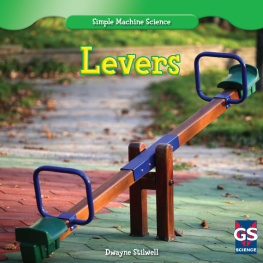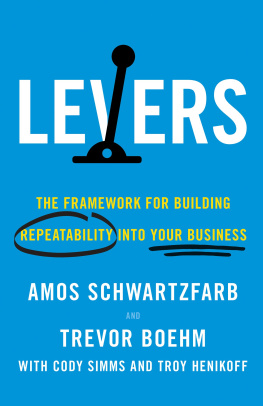Put
Levers
to the Test
Sally M. Walker and Roseann Feldmann
For my husband, Ron. Love you forever
RF
Copyright 2012 by Sally M. Walker and Roseann Feldmann
All rights reserved. International copyright secured. No part of this book may be
reproduced, stored in a retrieval system, or transmitted in any form or by any means
electronic, mechanical, photocopying, recording, or otherwisewithout the prior written
permission of Lerner Publishing Group, Inc., except for the inclusion of brief quotations in
an acknowledged review.
Lerner Publications Company
A division of Lerner Publishing Group, Inc.
241 First Avenue North
Minneapolis, MN 55401 U.S.A.
Website address: www.lernerbooks.com
Library of Congress Cataloging-in-Publication Data
Walker, Sally M.
Put levers to the test / by Sally M. Walker and Roseann Feldmann.
p. cm. (Searchlight booksHow do simple machines work?)
Includes index.
ISBN 9780761353218 (lib. bdg. : alk. paper)
1. LeversJuvenile literature. I. Feldmann, Roseann. II. Title.
TJ147.W36 2012
621.8dc22 2010035551
Manufactured in the United States of America
1 DP 7/15/11
Contents
Chapter
WORK
You work every
day. You do chores
around your home. At
school you write. It may
surprise you to learn that
playing and eating are
work too!
You do work when you write. What does the word work mean to a scientist?
Work = Using Force to Move an Object
When scientists use the word work, they dont mean the opposite of play. Work
is using force to move an object from one place to another. Force is a push
or a pull. You use force to carry out the trash. And
you use force to turn the page of a book.
You do work when you take out the trash.
Every time you use force, the force has a direction. Force can move in any direction. When you push open a door, the force is aimed away from you.
The direction of a force can be away from you.
You use an
upward force
to open some
kinds of windows.
And you use a
downward force
when you type on
a computer.
You use a downward force when you type.
Throwing a Ball Is Work
Every time your force moves an object, you have done work. It doesnt matter how far the object moves. If it moves, work has been done. Throwing a ball is work. Your force moves the ball from one place to another.
You do work when you move sand from one place to another place.
Pushing a Building Is NOT Work!
Pushing your school building is not work. Its not work
if you sweat. Its not work even if you push until your
arms feel like rubber. No matter how hard you push, you
havent done work. The building hasnt moved. If the
building moves, then you worked!
These kids are pushing very hard on a school building. But they are not doing work.
Chapter
MACHINES
Most people want their work to be easy. Machines are tools that make work easier.
Complicated Machines
Some machines have many moving parts. These machines are called complicated machines. Cars and vacuum cleaners are complicated machines.
A vacuum cleaner is
a machine that has many moving parts. What kind of machine
is it?
Simple Machines
Some machines have only a few moving parts. These machines are called simple machines. Simple machines are found in every home, school, and playground. They are so simple that you might not realize they are machines.
A light switch is a simple machine.
Simple machines
make work easier
in many ways. One
way is by changing
the direction of
force. When you use
your arms to lift a
friend, you use an
upward force. But
you can lift your
friend more easily by
using a downward
force. How?
Lifting a friend is hard.
The girl on the right sits on one end of the seesaw. The other end of the seesaw goes up and lifts her friend.
If your friend sits on a seesaw, the end your friend sits on goes down. When you sit on the other end, your friends goes up. Your force is downward. But your friend still goes up.
Chapter
PARTS OF
A LEVER
The seesaw is a simple
machine. This kind of simple
machine is called a lever. A lever
is a bar that is hard to bend. Levers
make it easier to move things.
A bottle opener is a simple machine called a lever. What do levers help people do?
A lever must rest on another object. The object a
lever rests on is called its fulcrum. You can make a lever.
What You Need
You will need a 12- inch (30- centimeter) wooden ruler, a crayon, a small can of food, and some rubber bands.
YOU CAN USE THESE OBJECTS TO
MAKE YOUR OWN LEVER.
Which part of the lever is the crayon?
What You Do
Place the ruler on the crayon. Put the crayon under the
rulers 6- inch (15 cm) mark. One end of the ruler will



























